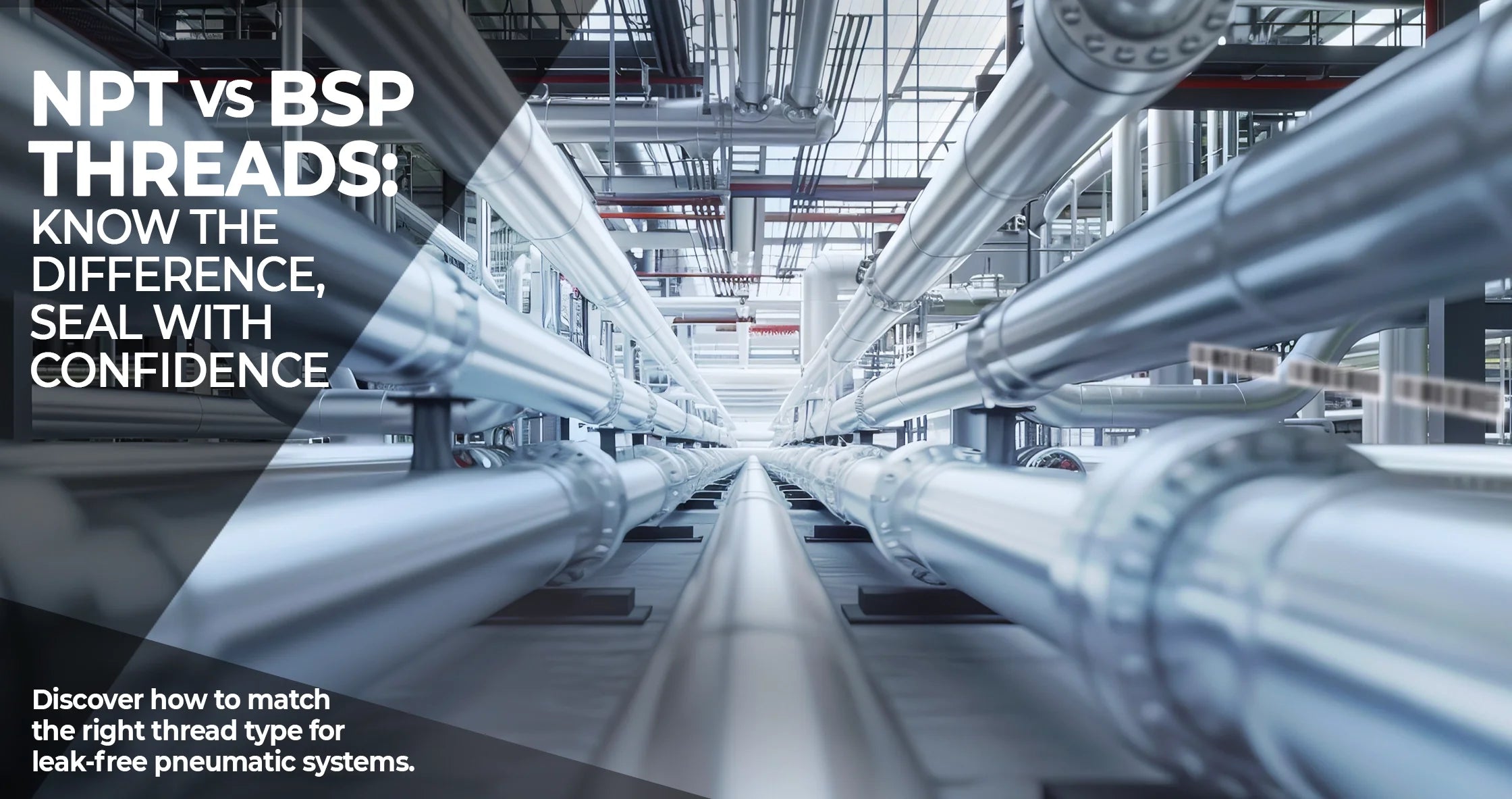When working with pneumatic systems, selecting the correct thread type for fittings is crucial. Two common types you'll encounter are NPT (National Pipe Thread) and BSP (British Standard Pipe). Understanding the differences in NPT vs BSP can mean the difference between a leak-free system and constant maintenance headaches. This guide dives into the core distinctions between NPT and BSP threads and how to choose the right fitting to ensure optimal performance and reliability.
Understanding NPT vs BSP Threads
At the heart of the NPT vs BSP discussion lies thread geometry. NPT threads are tapered and conform to U.S. standards, while BSP threads, used internationally, come in both parallel (BSPP) and tapered (BSPT) forms. The key to choosing the correct thread lies in knowing which standard your equipment or piping conforms to.
NPT Threads:
-
Developed in the U.S.
-
Tapered thread design (1°28')
-
Seals through thread deformation
-
Common in North America
BSP Threads:
-
Widely used outside North America
-
Comes in BSPT (tapered) and BSPP (parallel)
-
Seals using washers, o-rings (BSPP) or thread interference (BSPT)
-
ISO 228 (parallel) and ISO 7/1 (tapered) standards
The NPT vs BSP debate often stems from incorrect fittings being used interchangeably. While they may appear similar, they are not compatible due to differences in thread angle (60° for NPT vs 55° for BSP), pitch, and sealing method.
Why Pneumatic Systems Require Proper Thread Matching
In pneumatic systems, maintaining a leak-free seal is essential. Using mismatched threads not only causes air leaks but may damage equipment. Understanding the importance of NPT vs BSP in this context is vital to preserving system integrity.
Air leaks lead to:
-
Increased energy consumption
-
Reduced system efficiency
-
Potential safety hazards
Selecting the right thread means evaluating the system's origin, standards compliance, and seal integrity. NPT threads rely on thread deformation, often requiring thread sealant tape or compound, whereas BSPP threads typically need a bonded seal or washer.
NPT vs BSP: Major Differences in Thread Geometry
One of the most critical aspects of NPT vs BSP is how their threads are machined and how they seal.
1. Thread Angle:
-
NPT uses a 60-degree thread angle
-
BSP uses a 55-degree angle
2. Taper vs Parallel:
-
NPT and BSPT are tapered, BSPP is parallel
-
Tapered threads seal via mechanical interference
-
Parallel threads seal with o-rings or bonded washers
3. Threads per Inch (TPI):
-
Even threads with same nominal size can differ in pitch
-
Example: ½" NPT = 14 TPI, ½" BSP = 14 TPI but not interchangeable due to thread form
The NPT vs BSP issue often surfaces in multinational systems where components are sourced globally. Even a minor mismatch can create leaks that are hard to diagnose.
How to Identify NPT vs BSP Threads
Avoiding cross-threading or poor sealing starts with correct identification. Here's how to differentiate:
1. Visual Inspection
-
NPT: noticeable taper
-
BSPP: straight parallel profile
-
BSPT: tapered like NPT, harder to distinguish without measurement
2. Measuring Tools
-
Use a thread pitch gauge
-
Use calipers to measure thread OD (outer diameter)
-
Compare angle and pitch to standard charts
Properly identifying NPT vs BSP threads prevents costly mistakes, particularly in high-pressure pneumatic setups.
NPT vs BSP Sealing Mechanisms
The sealing method used is a defining feature of NPT vs BSP threads.
NPT Sealing:
-
Requires Teflon tape or pipe dope
-
Seals through metal-to-metal deformation
-
Effective but can gall if overtightened
BSPP Sealing:
-
Requires bonded washer or o-ring
-
Seals at face of fitting, not threads
BSPT Sealing:
-
Similar to NPT, but uses 55-degree threads
-
Thread sealant often recommended
Knowing how each thread type seals helps in selecting proper accessories and tools, ultimately leading to better system integrity.
Common Use Cases for NPT vs BSP in Pneumatics
Knowing where each thread type is commonly used helps in planning and compatibility checks:
NPT Fittings:
-
Pneumatic tools in North America
-
Compressed air systems
-
Air compressors and regulators
BSP Fittings:
-
Industrial pneumatic systems in Europe/Asia
-
Pressure gauges and sensors
-
Food-grade pneumatic lines (BSPP + o-ring for clean seal)
In international projects, mix-ups in NPT vs BSP fittings can delay installations and increase costs due to rework.
Can You Use Adapters Between NPT and BSP?
Yes, but it’s not always ideal. Adapters exist to connect NPT vs BSP threads, but they must be selected carefully.
Risks of Using Adapters:
-
Adds more potential leak points
-
Misalignment risk
-
Not always pressure rated for pneumatic systems
If you must adapt, use certified transition fittings and always pressure test the final assembly.
Industry Standards and Guidelines
Understanding global standards helps navigate NPT vs BSP compatibility:
-
ANSI/ASME B1.20.1 for NPT threads
-
ISO 7-1 for BSPT threads
-
ISO 228 for BSPP threads
When designing or maintaining pneumatic systems, always check documentation or manufacturer specs to determine whether fittings require NPT or BSP standards.
Tips for Choosing the Right Thread Type
Use the following tips to simplify your decision-making process regarding NPT vs BSP:
-
Identify System Origin: US-made = NPT; European/Asian = BSP
-
Check Documentation: Always review fitting specs
-
Use Proper Tools: Thread gauge, caliper, or consult a chart
-
Use the Right Seals: NPT = tape/dope; BSPP = washer/o-ring
-
Avoid Mixing Threads: Even if they seem to fit
Conclusion: NPT vs BSP in Pneumatic Fittings
The decision between NPT vs BSP fittings is not trivial. Each thread type has distinct advantages and specific applications. Understanding these differences can drastically reduce leaks, improve efficiency, and prolong equipment lifespan.
If you're setting up a pneumatic system or troubleshooting a leak, make thread identification your first step. Match fittings properly, use correct seals, and avoid makeshift solutions. In the world of pneumatics, a good seal is everything—and that starts with choosing the right thread.


